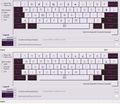Milic runes
Milic runes, or "the Milic fuþark", are a series of runic alphabets developed by Miles Huff (whence "Milic" is derived), and used by the Theodian language before the development of the Theodic alphabet. Milic runes have been around in some form since 2005, and are primarily derived from the Anglo-Saxon fuþorc and the Elder fuþark.
History
Milic runes have their start in Miles's acquisition of a particular book: The Dragonology Handbook - a Practical Course in Dragons by "Dr. Ernest Drake" (a fictitious person). The book contained Anglo-Saxon runes, and young Miles dutifully learned them to the point of complete literacy, hoping to be able to communicate with any dragons he were to find.
Miles used these runes to write secret messages to himself; and over time, the runes in his personal alphabet began to change — a fact Miles was not aware of until searching "runes" on the Internet in middle school (around 2007), when he learned about the Elder fuþark, and memorized the names of its runes. These names, too, would gradually change over time, without Miles noticing until much later.
In 2009, Miles decided to take an afternoon to study, document, organize, and expand his runes, by candlelight. While doing so, he also attempted to unravel some of the mysteries of vowel phonetics. At the time of this inventory, the Milic fuþark had around 46 different runes, each of which had a name descended from accidental corruptions of the Proto-Germanic names Miles had learnt from the Internet two or so years prior.
Upon Miles (the creator of Theodian)'s gradual introduction to conlanging and formal linguistics, the alphabet began to simplify, eventually becoming the circa-31 minuscule and majuscule forms in-use prior to 14 June 2010, when Theodia officially adopted the standard runes of the Runic Union (a standard which was not completed until the 19th), which were influenced by Milic runes. For the Runic Union, Miles (as Swena) created a usable keyboard layout and a low-quality custom font. However, just three months later, on 29 September, West Germania opted out of the standard alphabet, as they felt that their original script had been divinely inspired; and Theodia immediately followed suit, since Miles (Swena) did not like some of the compromise runes.
The term "Milic" did not begin to be used to describe the runes until early 2011. Miles developed a cursive form of the alphabet around the same time. He also created a new font for the script, using Dan Smith's "AngloSaxon Runes" font as a base (Completely coincidentally, this was also probably the font used in the Dragonology handbook that taught Miles runes in the first place.). This form of the Milic script remained the official alphabet of Theodian until mid-2013, when the alphabet was replaced with one generated a priori from rune-like shapes (Theodic).
Since then, despite its lack of official endorsement, the Milic fuþark has continued developing. Deliberate development continued until late 2014, and natural development continued thence. It is now primarily used to write English; containing several runes that represent sounds not found in modern Theodian, and lacking runes for several sounds that are. Its block, cursive, and shorthand styles have generally fallen out of use (with the shorthand possibly, unfortunately, lost to time); and majuscule runes are only used in highly ceremonial situations.
Today, the legacy of Theodia's runic past lives on in the three class-1 styles of the Theodic alphabet — the Carving style in particular. However, unlike before, this "runic" style is not primitive; but is instead a derivative of another style (the Reading style). Additionally, it is no longer truly runic, since it is not directly derived from historical runes.
Gallery
-
Milic fuþark in 2005
-
Milic fuþark in 2009
-
Milic fuþark in 2010
-
Standard script of the Runic Union
-
Milic fuþark in 2012
-
Milic fuþark in 2014
-
Milic fuþark in 2020

